When it comes to eating fruit and vegetables, we have all got the message: the required number is five. More is even better. The message is so ubiquitous, it has taken on a life of its own, a fame way beyond its achievements. If you shop at supermarkets or buy lunch from a chain such as Pret a Manger, Eat, Boots or Marks & Spencer, you will see your fruit and veg tally accruing as you shop. It will follow you around the aisles. There is no avoiding it. Packaging of processed and fresh fruits and vegetables are spattered with stickers and smileys advertising how many of the government's recommended five-a-day each product delivers. Eight brussels sprouts, 11 grapes, a pot of fruit jelly. The labels are so helpfully specific that good health appears to be a matter of simple arithmetic.
But in all kinds of ways, the numbers aren't adding up. The National Diet and Nutrition Survey released today shows that 70% of UK adults eat fewer than five portions of fruit and veg a day, let alone the seven recommended last month by researchers at University College London. The data, collected by NatCen Social Research, shows a slight drop in fruit and vegetable intake in all age groups apart from the over-65s between 2008 and 2012. Why has a campaign that is so well known failed to deliver?
When the government launched its five-a-day programme in 2003, it wanted to make healthy eating as easy as counting on the fingers of one hand. It arrived at the figure of five simply by chopping up the World Health Organisation's recommended minimum daily 400g of fruit and veg into a bite-size marketing message. It also echoed the "five a day – for better health!" campaign launched in California in 1988 and later taken up across the US. Those 80g portions were a kind of finger food for the brain: easy to digest. They never claimed to tell the whole story, just to get people started. The advice from WHO and the British government was always to eat "at least" five a day.
Sheela Reddy was the principal nutritionist for the department of health, who launched the campaign 11 years ago. "We wanted to make it as easy as possible for people to attain five a day," she says. "Now, when I think about it, even that doesn't seem to have helped much. As far as the UK is concerned, we do have a problem with five a day. We haven't done it." She says "it might be worth reworking the five-a-day message" to exclude fruit juice, "now we know that it is not that wonderful" – which would lead to an even greater drop in intake.
Try for a moment to picture the official five-a-day logo. "The intention was that everyone would adopt that logo," Reddy says. "Retailers, everybody." But these days the logo, with its ghostly green steps fading to yellow, a staircase to sunnier health, is largely absent from the major supermarket chains. In Iceland, one of the first chains to sign up to it, the official logo can be found only on a packet of spring onions (in Hackney's Mare Street branch, at least). Only a handful of manufacturers – such as Tropicana, Whitworth dried fruits, Sunmaid raisins – continue to include it on their packaging. The official logo has faded from view, and its demise seems symbolic, for it matches the government's shifting of responsibility for the campaign from the department of health to Public Health England, and its absorption into the broader Change4Life health campaign. As a result, power has shifted towards manufacturers and retailers. In the aisles of supermarkets, an unofficial five-a-day pictogram jungle is flourishing.
To sanction use of its official logo, the government requires from manufacturers a cheque for £100 and a signed promise that the product contains pure fruit or vegetable matter without the addition of salt, fat or sugar. No product sample is needed. But these specifications were too stringent for the many products, from soups to pizzas, that include fruit and vegetables among other ingredients. The company to which the government outsourced the licensing of the official logo, NSF International, declines to say how many applications it receives, but shop shelves suggest the number is small. After all, who needs an official logo when you can simply devise your own? Two years ago, Which? called for five-a-day logos to be removed from products containing high levels of salt or sugar, citing Heinz spaghetti hoops. But today even Heinz Peppa Pig pasta shapes promise one of the daily five, in a "one of your five a day" badge that is the same distinctive shape as the Heinz logo – as if five a day is what Heinz really meanz.

In many ways, the five-a-day campaign has become a victim of its own success. The message has outstripped the eating habits it was meant to change. For although most consumers fall short of the target, the message is known to all. Alison Lennox, an editor on the National Diet and Nutrition Survey, says that "90% of people know about the recommendation of five a day". Unlike most government health campaigns, consumers understood it. But the message has made fruit and vegetables – especially prepared or processed fruit and vegetables – marketable. And by giving leeway to individual manufacturers and retailers, it has opened up space in which ambiguity and imprecision can flourish.
"It's been a phenomenally successful public health campaign," says Nicole Rothband of the British Dietetic Association. "It is so well understood, so embedded in the psyche, that people make jokes about Opal Fruits and Jammy Dodgers being one of your five a day. I only fear that it's being exploited and manipulated, not so much devalued but misrepresented, so that it ultimately starts to confuse people, and they start to question the message. People are confused by the mass of information out there now."
The confusion arises the moment consumers start to read labels. Although these are meant to conform to the government's specification of 80g portion sizes, tremendous disparity prevails. At Waitrose, one kiwi is one of your five a day. At Marks & Spencer, you need to eat two. There are discrepancies even within the same retailer. In M&S, you need to eat two handfuls of blueberries to accrue another portion, but if you purchase the raspberry/blueberry composite pack, one will do. At Asda, seven cherry tomatoes count as one portion, but at Waitrose you need to eat 10 and at M&S only three. The mathematics of this last one do not bear examination, as the entire pack weighs 220g and contains 17 tomatoes, making three tomatoes only half the requisite 80g. Tesco even sells own-label pitted prunes that promise "half of one of your five a day". Tomato puree advertises one of your five in just a teaspoon: tempting. Five-a-day labelling, in short, is all over the place. (M&S says it is updating its labelling on the products mentioned in this piece and new labelling "will appear in the next few months".)
"I think a lot of people are still confused about the portions," says Reddy. "We used to get so many manufacturers calling up saying, 'We are preparing these bags of strawberries and blueberries. How should we label it?' " In the two years leading up to the five-a-day launch in 2003, Reddy "did a lot of work" on portion sizes. "I even looked at glove sizes," she says. She went to the British Standards Institution to try to understand what a portion might be. "They said there is no standard spoon size. Spoons change with fashion."
But why are the differences between shops so great? Consider a shopper at an out-of-town retail park who wishes to buy some pineapple to satisfy one of her five a day. First, she goes into Marks & Spencer and finds a pack of prepared fruit for £2, promising one of her five a day – even though at 260g it actually comprises more than three portions. Next, she goes into Waitrose and finds that if she buys her chopped pineapple here, she need eat only eight chunks to have eaten a portion of fruit. At Asda, she can buy a tiny slice of pineapple for 50p, weighing exactly 80g, and one of her five a day. At all these stores, a whole, fresh pineapple – the more economical purchase – carries no five-a-day marketing at all. Not on the fruit – understandably – but not on the shelf either.
Retailers use the five-a-day labelling more routinely on products with a higher profit margin – prepared fruits and salads, packaged vegetables and so on. Loose fruits and vegetables – usually the cheapest option – are rarely labelled as one of your five a day, whether you shop at Iceland or Tesco. At Waitrose, the link between higher-cost products and the five-a-day labelling is even more apparent.
The store's cheaper Essentials range contains almost no five-a-day labelling. So, a plain old orange sold under the Essentials banner (costing £1.99 a bag) appears not to contribute to your daily count. But splurge £3.19 on a bag and one "seedless sweet and exceptionally juicy large navel orange" takes care of one of your five portions. Perhaps they price up the adjectives by the pound too.
Intriguingly, the only apples in the Essentials range that advertise five-a-day benefits are the pink lady apples. At £3 a bag, these cost £1.25 more than royal galas or braeburns, which advertise no five-a-day benefits. Well, they are pink ladies, and the pink lady is the poshest apple on the high street. Whether this is an accidental or subconscious anomaly on the part of Waitrose, it is impossible to know. Waitrose, like M&S, says this range is "being updated with five-a-day messaging". Currently, however, the shopper with greater means can more consciously accrue their recommended daily intake of fruit and veg.
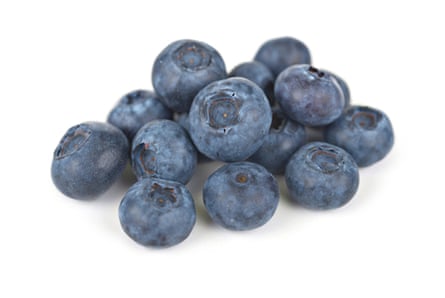
Labelling is about selling, not informing. "A lot of people seem to imagine that 80g is a lot," says Reddy, sounding bewildered. "Actually, 80g is a small amount." But, of course, the larger the quantity of chopped fruit in a pot, for instance, the higher the profit margin. Perhaps that is one reason why people on lower incomes consume fewer daily portions of fruit and vegetables. Research consistently shows that these consumers are harder to reach. And the supermarkets' labelling efforts seem more exuberant on products that cost a premium. At Pret a Manger, for instance, there is a clear invitation to up-purchase. For £2.25, customers can eat two portions of fruit by buying, say, a pot of chopped melon and blueberries. Or pay an extra 54p and upgrade to three portions.
These distinctions may seem fine or petty but they matter because the five-a-day campaign has tapped into the trend for a smoothification of food. For years, fruit was celebrated as the ultimate convenience food, but now manufacturers seek to render fruit in supra-convenient forms. Children go to school with mutant fruit forms in their lunchboxes – fruit strings, fruit shapes, fruit chews – that are made from juice and puree concentrate. Some have an alarming sugar content, yet they promise on the box to provide one of the five a day. Healthbars such as Nakd fit this category and promise to deliver one of your five a day, based on the quantity of freeze-dried date paste used. "All the wholesalers have different dehydration levels," says Liz Tucker, a nutritionist who names Nakd among her clients. "It gives you an indication of how small nutrients actually are. Freeze dried, all you are doing is taking it down to supplement size."
Compared to gulping down a few fruit chews or cracking open a fruit bar, eating an apple – which needs washing – or a banana – whose wrapper won't stuff in a pocket if you care about your pockets – seems too much hassle. We like our food smoothified now. And for retailers and manufacturers, the five-a-day marketing strategies have offered a way of bringing to our love of sugar the validation of a public health campaign.
The problem is that smoothifying food leads to increased calorie consumption. "A lot of food of plant origin isn't terrifically well digested," says Thomas Sanders, professor of nutrition and dietetics at King's College London. "By smoothifying it you're increasing the digestibility of it, and you get more calories out of it. If you can wolf it down, that's going to be fattening. Picking your way through a bunch of grapes takes quite a long time. Compare that to a handful of dried fruit. It's the time taken to eat that is important, the act of chewing. One of the things we know is that people who bolt their food down are more likely to put on weight."
"I aim to do my seven a day without eating these processed things you are describing," says Oyinlola Oyebode, lead investigator of UCL's report, which argued the enhanced benefits of eating seven-plus portions of fruit and veg a day. She keeps a vegetable peeler "like a pencil sharpener" on her desk, along with a bag of carrots, tomatoes and radishes. Even Oyebode, however, who eats seven or more portions of fruit and veg a day without needing to count, is uncertain whether the five-a-day message should be altered.
"There are downsides to changing because the message is so well recognised," she says. "Then there is the question of whether a big target puts people off eating any at all. There is good evidence that eating more than five portions a day is important but I don't know whether changing the message is the best way to encourage people to do that."
Perhaps the best thing is to ignore the labels and for one day weigh your fruit and vegetables. It is a revealing exercise: two large strawberries, six radishes, one easy peeler (despite the packaging specifying two) each make a portion. Five – or even seven – may not be so hard to achieve when you look at the food, and not at the profit margins.
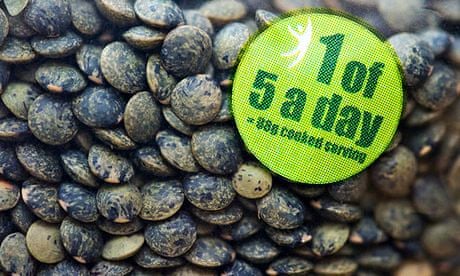
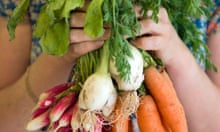


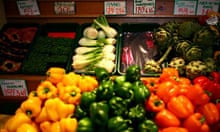
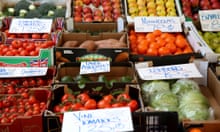
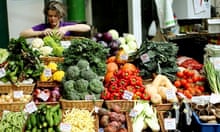

Comments (…)
Sign in or create your Guardian account to join the discussion